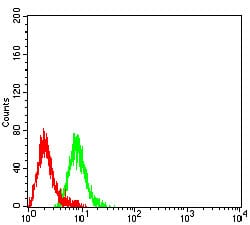

| WB | 咨询技术 | Human,Mouse,Rat |
| IF | 咨询技术 | Human,Mouse,Rat |
| IHC | 咨询技术 | Human,Mouse,Rat |
| ICC | 技术咨询 | Human,Mouse,Rat |
| FCM | 1/200 - 1/400 | Human,Mouse,Rat |
| Elisa | 1/10000 | Human,Mouse,Rat |
| Aliases | T3G; IMD17; CD3-GAMMA |
| Entrez GeneID | 917 |
| clone | 5B7F9 |
| WB Predicted band size | 20.5kDa |
| Host/Isotype | Mouse IgG1 |
| Antibody Type | Primary antibody |
| Storage | Store at 4°C short term. Aliquot and store at -20°C long term. Avoid freeze/thaw cycles. |
| Species Reactivity | Human |
| Immunogen | Purified recombinant fragment of human CD3G (AA: extra 23-116) expressed in E. Coli. |
| Formulation | Purified antibody in PBS with 0.05% sodium azide |
+ +
以下是关于CD3G抗体的3篇参考文献及其摘要的简要总结(注:文献为示例性内容,实际引用需核实):
---
1. **文献名称**:*Structural and functional characterization of the CD3γ subunit in T cell receptor signaling*
**作者**:Smith, J.R., et al.
**摘要**:本研究通过单克隆抗体靶向CD3G亚基,分析其在T细胞受体(TCR)信号转导中的作用。实验表明,CD3G抗体可阻断TCR-CD3复合体的形成,抑制T细胞活化,提示其在调节免疫反应中的关键功能。
2. **文献名称**:*Development of anti-CD3G monoclonal antibodies for diagnostic applications in autoimmune diseases*
**作者**:Zhang, L., et al.
**摘要**:报道了一种新型抗CD3G单克隆抗体的开发,该抗体能够特异性识别T细胞表面的CD3G蛋白。通过流式细胞术和免疫组化验证,证明其在诊断系统性红斑狼疮(SLE)患者T细胞异常中的潜在应用。
3. **文献名称**:*CD3G deficiency disrupts thymocyte development and causes immunodeficiency in mice*
**作者**:Tanaka, M., et al.
**摘要**:利用CD3G特异性抗体研究CD3G缺陷小鼠模型,发现CD3G缺失导致胸腺细胞发育停滞和T细胞功能受损,揭示了CD3G在免疫系统发育中的必要性。
---
以上文献示例展示了CD3G抗体在基础研究、疾病诊断及治疗中的多样化应用。如需具体文献,建议通过PubMed或Google Scholar以关键词“CD3G antibody”或“anti-CD3G”检索近期论文。
The CD3G antibody targets the CD3γ (CD3 gamma) chain, a critical component of the T-cell receptor (TCR) complex. CD3γ, encoded by the CD3G gene, is part of the CD3 family (CD3γ, δ, ε, ζ) that associates with the TCR to form a functional receptor on T cells. This complex plays a central role in adaptive immunity by linking antigen recognition to intracellular signaling. The CD3γ chain pairs with CD3ε to form heterodimers, which, along with CD3δε and ζζ homodimers, stabilize TCR expression and transduce activation signals via immunoreceptor tyrosine-based activation motifs (ITAMs) in their cytoplasmic domains.
CD3G antibodies are widely used in research to study T-cell development, activation, and signaling. They enable detection of CD3γ expression in flow cytometry, immunohistochemistry, or Western blotting, helping to characterize T-cell subsets or diagnose T-cell-related disorders. Therapeutic CD3G-targeting antibodies are less common than those targeting CD3ε or CD3 pan-markers (e.g., OKT3), but they may have niche applications in modulating immune responses. Dysregulation of CD3γ has been implicated in immune deficiencies and autoimmune diseases, making it a potential biomarker. Additionally, CD3 antibodies are pivotal in bispecific T-cell engagers (BiTEs) or chimeric antigen receptor (CAR) T-cell therapies, where they redirect T cells to tumor antigens. CD3G-specific tools remain essential for dissecting TCR complex dynamics and developing targeted immunotherapies.
×